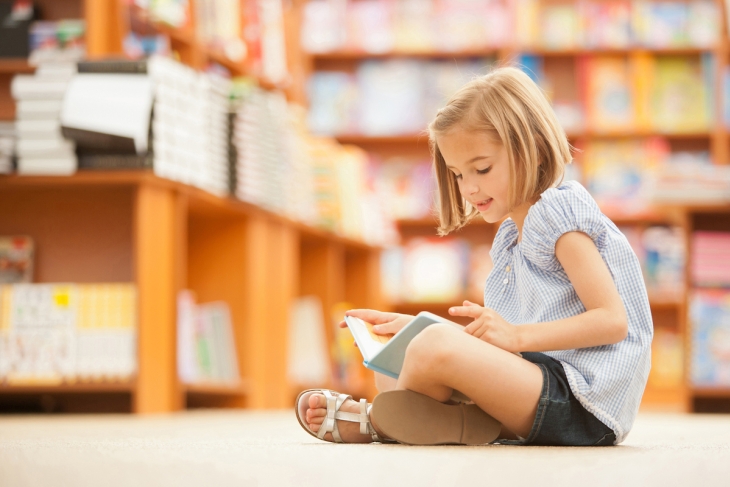A few months ago, I was invited to give a talk to teachers in Ft. Collins, Colorado. My host was Casey Churchill, who runs Liberty Common School, a charter school with a classical curriculum. Afterwards, I sat in on a professional development session with the school’s librarian, who was explaining the school’s library collection procedures. While most of the country debates restricting children’s access to books, at Liberty, a Core Knowledge school that emphasizes character education, the debate runs in the opposite direction: Which books should kids be reading?
For years, Liberty has maintained lists of recommended books for parents to read aloud with little kids, or for independent reading for older students. The school’s academic advisory committee actively reads and approves every single book on the list, not just for “age appropriateness” and themes, but for text complexity, vocabulary, and syntax (too many incomplete sentences, casual language, or overuse of slang are strikes against a book), and for “domain knowledge,” such as whether a book’s historical and scientific references are accurate. But the most interesting screens are for “moral literacy” and meaning. Liberty’s evaluation rubric asks questions that many educators would likely not even consider or might be uncomfortable weighing if asked: Would we want our students to live the life of the characters in this story? What is the compelling reason we want students to read this book?
We have become almost entirely unaccustomed to thinking about books as a contributing factor in character formation, but at Liberty it’s a central consideration. Not long ago, a parent wanted to add books from the popular “Junie B. Jones” series to the list for K–2. The suggestion was denied. “The main character is brash and obnoxious,” Churchill explains. “We don’t want to teach kids that it’s OK to be a brat.” Ditto the Rick Riordan book The Red Pyramid. At first glance, the book might appear to be a strong contender since it’s based on Egyptian mythology, which reinforces Liberty’s Core Knowledge curriculum. Not only was the book’s language and sentence structure found wanting, but the main character was deemed to have too little respect for his father and siblings. “Overall, this isn’t a book we want to encourage the students to read because it doesn’t inspire, elevate, or add value to the students,” was the verdict. To be clear, Liberty students can still read The Red Pyramid on their own—it wasn’t “banned”—but neither was it added to the select list of “recommended” books.
As a school of choice, Liberty enjoys a permission structure that allows it to be this selective and prescriptive, and that might be difficult for traditional public schools to emulate. When parents vote with their feet, you can reasonably infer that they are supportive of a school’s culture and curriculum. Still, it was a breath of fresh air to speak with educators who are crystal clear on their school’s culture and values. They’re thinking very intentionally as adults about the signals they’re sending to kids about the ideals and behaviors they seek to promote among children.
Liberty’s recommended reading list and its emphasis on moral literacy, themes, literary merit, and character development draws inspiration from William Kilpatrick’s 1993 book Why Johnny Can’t Tell Right from Wrong: And What We Can Do About It. “Good literature,” Kilpatrick insisted, “doesn’t introduce a child to ‘kids like me’ but to others who are better than himself—who are just like he might become if he fulfills his potential for goodness.”
Of course, introducing students to “kids like me” is often precisely the justification given for clearing shelf space for some particularly controversial books, such as Gender Queer, Lawn Boy, and All Boys Aren’t Blue. “There are a lot of people who are questioning their gender, questioning their sexuality, and having a real hard time finding honest accounts of somebody else on the same journey,” notes Maia Kobabe, the author of Gender Queer. “There are people for whom this is vital and for whom this could maybe even be lifesaving.”
Churchill is unpersuaded by such didactic views of the role of literature. And unapologetic in response. “We just don’t think that ‘kids like me’ books are necessary or important in schools,” he explains. “There are a lot of values-based books that begin to step on the toes of parents. We need to be respectful of values they want to impart to their kids.” Is there a role for schools in signaling inclusivity? Churchill isn’t so sure and likens that query to asking for a sandwich at Jiffy Lube. “They do oil changes. They don’t do sandwiches,” he responded. “Schools should do education and academics. We don’t do sexual preferences or mental health. That’s the job of the family and parents.”
The average middle school library has a collection of 13,000 volumes, a figure that represents fewer than one out of every ten thousand books ever written in English. Over the course of our lifetimes, most of us will read only a tiny fraction of those—far fewer than a thousand books. Given these figures—massive supply, minimal demand—our current obsessive argument about limiting children’s access to certain books in school libraries feels a bit like insisting there are grains of sand on the beach we must not put our blankets on. Coming at this question from the opposite direction—which books are worth students’ time?—is a refreshing approach to this divisive issue.
Churchill is quick to add that no one should confuse his school’s refusal to add books to its curriculum or recommended reading lists with a “ban” on books that don’t make the cut. “There are just good books that we want to have in front of our kids,” he said.


